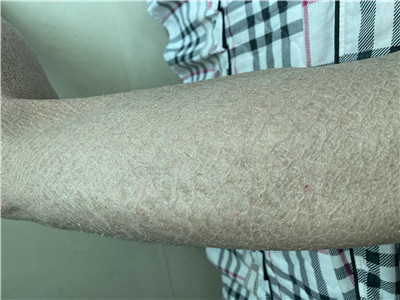What is ichthyosis vulgaris?
Ichthyosis is a skin disease with more than 20 varieties. Ichthyosis vulgaris is the most common and mild ichthyosis. Among people with some form of ichthyosis, 95% have ichthyosis vulgaris.
Ichthyosis vulgaris is often mistaken for simple dry and squamous skin, so it is easy to miss diagnosis. If twice daily use of moisturizing cream does not help, dermatologists can diagnose ichthyosis vulgaris by examining the skin and distinguishing it from other skin diseases.
Before seeing a doctor:
Find out if your blood relatives have similar skin conditions.
Note when the symptoms first appear.
List any other medical or skin conditions you have and the medications, vitamins and supplements you are taking.
The doctor may perform a biopsy (remove a small part of the skin to examine it under a microscope). Since the disease can be passed on to children, doctors may also require genetic testing.

Symptoms of ichthyosis vulgaris include:
Dry and itchy skin
Thick and rough skin that looks dirty, most notably the palms and soles of the feet
White, gray or brown scales on the front of the legs, back of the arms, scalp, back or abdomen. If scales appear on the face, they are mainly on the forehead and cheeks. Sometimes the edges of the scales curl, making the skin feel rough.
Extra lines on the palms and soles of the feet. In severe cases, these lines can be very deep, causing cracks in the skin. If the crack is deep enough, infection may occur.
Rough lumps (hair keratosis) on the arms, thighs and hips. Bumps are often mistaken for acne blemishes.
Unable to sweat fully (sweating). This can happen in severe cases and can lead to overheating (because sweat can cool the body).
Many patients do not realize that they have ichthyosis vulgaris because the symptoms can be very mild. They just think their skin is dry, so they apply moisturizer to reduce scaling.
Ichthyosis vulgaris gets worse in winter because cold and dry air can cause symptoms. In summer, due to the warm and humid air, the disease can almost disappear.
Sometimes patients notice the symptoms of ichthyosis vulgaris before they are diagnosed with a more serious disease. On the other hand, the symptoms of ichthyosis vulgaris sometimes appear years after the patient is diagnosed with a more serious disease.
For some children with ichthyosis vulgaris, scales become less obvious during adolescence. In other cases, symptoms may disappear in childhood and recover in adolescence or even adulthood.
This usually improves with age. In most cases, people with ichthyosis vulgaris live a normal life, although they may always need to treat their skin. The disease rarely affects overall health.
Previous: How Often to Change Cat Litter?
Next: 250g Dry Food Grinder for Spice/grains/pearl/coffee mini food grinder electric
Copyright:@2020-2021
Comments Please sign in or sign up to post.
0
0 of 500 characters used